Combining Multi-Source Remotely Sensed Data and a Process-Based Model for Forest Aboveground Biomass Updating
Abstract
1. Introduction
- (1)
- Develop an approach to generate the time series of LAI products with fine spatial resolution as important input parameters to drive the BEPS model;
- (2)
- Add a small physical-based module to update the spatiotemporal variations of baseline forest AGB based on the BEPS model, and;
- (3)
- Test and validate the updated forest AGB using the results obtained from field- and ALS-based methods.
2. Preparation
2.1. Study Area
2.2. Data
2.2.1. Field Measurement Data
2.2.2. National Forest Inventory Data
2.2.3. LAI Time Series Data
- MODIS-based LAI time series data
- Landsat-based LAI time series data
2.2.4. Forest Types Data
2.2.5. Meteorological Data
2.2.6. Aerial Laser Scanning Data
3. Materials and Methods
3.1. Forest Aboveground Biomass Mapping
- Field-based forest aboveground biomass
- Landsat-based forest aboveground biomass
- ALS-based forest aboveground biomass
3.2. Forest Aboveground Biomass Updating
3.2.1. Net Primary Productivity Simulation
3.2.2. Updating Forest Aboveground Biomass
3.3. Accuracy Assessment
4. Results
4.1. Forest Types Map
4.2. Forest Aboveground Biomass Map
4.2.1. Landsat-Based AGB of 2008
- After assuming that the empirical relationship between the field-based LAI and AGB was universal with the same remote sensor, sampling season and study area in different years, we generated the forest AGB map of 2008 based on the statistical model built using the forest field data collected in the summer of 2012 and 2013.
- As shown in Table 3, the field-based LAI was used as independent variable to build the statistical model with field-based forest AGB at forest plot level to produce Landsat-based forest AGB map. The needle leaf forest had the best correlation coefficient (R2 = 0.72, n = 24, p < 0.01), and the Landsat TM/ETM+ image-based LAI of broadleaf forest and mixed forests explained 42% (n = 21, p < 0.05) and 57 % (n = 29, p < 0.01) of variations in field-based forest AGB, respectively. Finally, the forest AGB map of 2008 based on the developed model was generated and served as the baseline data to parameterize the ecological process-based model to simulate the annual AGB variations.
4.2.2. ALS-Based AGB of 2012
- We built the stepwise regression model with the field-based forest AGB as a dependent variable by inputting various ALS-based canopy metrics including nine canopy percentile heights, mean height and plot density (Table 4) as independent variables. It was found that the canopy mean height did a good job in predicting the variations in field-based forest AGB with the linear regression model as AGB = 0.826 × hm − 3.208 (R2 = 0.83, n = 26, p < 0.01, RMSE = 1.09 kg/m2).
- After getting the ALS-based forest AGB map, we found that it had a heterogeneous spatial distribution pattern with maximum, minimum, and average values of 16.27 kg/m2, 0.06 kg/m2, and 6.07 kg/m2, respectively. By comparing the forest AGB of 2012 between the ALS- and field-based methods, high correlation (R2 = 0.81, n = 26, p < 0.01) was observed (Figure 4), which showed that the ALS-based forest AGB could serve as a validation data for the BEPS results.
4.3. Forest Aboveground Biomass Update
4.3.1. Carbon Pools Initialization
4.3.2. GPP, NPP, and AGB Variations
4.3.3. Updated Forest Aboveground Biomass
5. Discussion
5.1. Landsat Radiative Normalization
5.2. Uncertainties in LAI Time Series Images
5.3. Updated Forest Aboveground Biomass
5.4. Uncertainties in Updated Forest Aboveground Biomass
5.5. Management Implications and Future Researches
6. Conclusions
- The process-based model driven by multi-source remotely sensed data could be used to dynamically forecast and update the forest AGB at the landscape level. The BEPS-based results explained 31% of variation in the field-based AGB and 85% of variation in the ALS-based AGB with the confidence level higher than 95%.
- Both forest biotic (i.e., LAI, forest type etc.) and abiotic factors, such as soil type data and meteorological data, were considered in predicting the spatiotemporal distribution of forest AGB through the process-based ecological model.
- Since the Landsat-based AGB predicted 99.0%, 93.8%, and 87.3% of variation in the wood biomass, coarse root biomass and leaf biomass, respectively, the initial forest AGB spatial distribution map can be used to parameterize the forest carbon pools quantitatively characterized in the process-based model.
Acknowledgments
Author Contributions
Conflicts of Interest
References
- Shanin, V.N.; Mikhailov, A.V.; Bykhovets, S.S.; Komarov, A.S. Global climate change and carbon balance in forest ecosystems of boreal zones: Simulation modeling as a forecast tool. Biol. Bull. 2010, 37, 619–629. [Google Scholar] [CrossRef]
- Pelt, R.V.; Sillett, S.C.; Kruse, W.A.; Freund, J.A.; Kramer, R.D. Emergent crowns and light-use complementarity lead to global maximum biomass and leaf area in sequoia sempervirens forests. For. Ecol. Manag. 2016, 375, 279–308. [Google Scholar] [CrossRef]
- Le Toan, T.; Quegan, S.; Davidson, M.; Balzter, H.; Paillou, P.; Papathanassiou, K.; Plummer, S.; Rocca, F.; Saatchi, S.; Shugart, H. The biomass mission: Mapping global forest biomass to better understand the terrestrial carbon cycle. Remote Sens. Environ. 2011, 115, 2850–2860. [Google Scholar] [CrossRef]
- Zheng, G.; Chen, J.; Tian, Q.; Ju, W.; Xia, X. Combining remote sensing imagery and forest age inventory for biomass mapping. J. Environ. Manag. 2007, 85, 616–623. [Google Scholar] [CrossRef] [PubMed]
- Motohka, T.; Yoshida, T.; Shibata, H.; Tadono, T.; Shimada, M. Mapping aboveground biomass in northern japanese forests using the alos prism digital surface model. IEEE Trans. Geosci. Remote Sens. 2015, 53, 1683–1691. [Google Scholar] [CrossRef]
- Zhang, Y.; Liang, S. Changes in forest biomass and linkage to climate and forest disturbances over northeastern China. Glob. Chang. Biol. 2014, 20, 2596–2606. [Google Scholar] [CrossRef] [PubMed]
- Bellassen, V.; Le Maire, G.; Dhôte, J.-F.; Ciais, P.; Viovy, N. Modelling forest management within a global vegetation model—Part 1: Model structure and general behaviour. Ecol. Model. 2010, 221, 2458–2474. [Google Scholar] [CrossRef]
- Muukkonen, P.; Heiskanen, J. Biomass estimation over a large area based on standwise forest inventory data and aster and modis satellite data: A possibility to verify carbon inventories. Remote Sens. Environ. 2007, 107, 617–624. [Google Scholar] [CrossRef]
- Blackard, J.; Finco, M.; Helmer, E.; Holden, G.; Hoppus, M.; Jacobs, D.; Lister, A.; Moisen, G.; Nelson, M.; Riemann, R. Mapping us forest biomass using nationwide forest inventory data and moderate resolution information. Remote Sens. Environ. 2008, 112, 1658–1677. [Google Scholar] [CrossRef]
- Powell, S.L.; Cohen, W.B.; Healey, S.P.; Kennedy, R.E.; Moisen, G.G.; Pierce, K.B.; Ohmann, J.L. Quantification of live aboveground forest biomass dynamics with landsat time-series and field inventory data: A comparison of empirical modeling approaches. Remote Sens. Environ. 2010, 114, 1053–1068. [Google Scholar] [CrossRef]
- Zhang, X.; Kondragunta, S. Estimating forest biomass in the USA using generalized allometric models and modis land products. Geophys. Res. Lett. 2006, 33, 1–5. [Google Scholar] [CrossRef]
- Fayad, I.; Baghdadi, N.; Gond, V.; Bailly, J.-S.; Barbier, N.; El Hajj, M.; Fabre, F. Coupling potential of icesat/glas and srtm for the discrimination of forest landscape types in French Guiana. Int. J. Appl. Earth Obs. 2014, 33, 21–31. [Google Scholar] [CrossRef]
- Fayad, I.; Baghdadi, N.; Guitet, S.; Bailly, J.-S.; Hérault, B.; Gond, V.; El Hajj, M.; Minh, D.H.T. Aboveground biomass mapping in french guiana by combining remote sensing, forest inventories and environmental data. Int. J. Appl. Earth Obs. 2016, 52, 502–514. [Google Scholar] [CrossRef]
- Muukkonen, P.; Heiskanen, J. Estimating biomass for boreal forests using aster satellite data combined with standwise forest inventory data. Remote Sens. Environ. 2005, 99, 434–447. [Google Scholar] [CrossRef]
- Nelson, R.; Ranson, K.; Sun, G.; Kimes, D.; Kharuk, V.; Montesano, P. Estimating siberian timber volume using modis and icesat/glas. Remote Sens. Environ. 2009, 113, 691–701. [Google Scholar] [CrossRef]
- Hauglin, M.; Dibdiakova, J.; Gobakken, T.; Næsset, E. Estimating single-tree branch biomass of norway spruce by airborne laser scanning. ISPRS J. Photogramm. Remote Sens. 2013, 79, 147–156. [Google Scholar] [CrossRef]
- Hauglin, M.; Astrup, R.; Gobakken, T.; Næsset, E. Estimating single-tree branch biomass of norway spruce with terrestrial laser scanning using voxel-based and crown dimension features. Scand. J. For. Res. 2013, 28, 456–469. [Google Scholar] [CrossRef]
- Wang, D.; Xin, X.; Shao, Q.; Brolly, M.; Zhu, Z.; Chen, J. Modeling aboveground biomass in hulunber grassland ecosystem by using unmanned aerial vehicle discrete lidar. Sensors 2017, 17, 180–199. [Google Scholar] [CrossRef] [PubMed]
- Hajj, M.; Baghdadi, N.; Fayad, I.; Vieilledent, G.; Bailly, J.-S.; Minh, D. Interest of integrating spaceborne lidar data to improve the estimation of biomass in high biomass forested areas. Remote Sens. 2017, 9, 213–232. [Google Scholar] [CrossRef]
- Fayad, I.; Baghdadi, N.; Bailly, J.-S.; Barbier, N.; Gond, V.; Hajj, M.E.; Fabre, F.; Bourgine, B. Canopy height estimation in french guiana with lidar icesat/glas data using principal component analysis and random forest regressions. Remote Sens. 2014, 6, 11883–11914. [Google Scholar] [CrossRef]
- Ni, W.; Ranson, K.J.; Zhang, Z.; Sun, G. Features of point clouds synthesized from multi-view alos/prism data and comparisons with lidar data in forested areas. Remote Sens. Environ. 2014, 149, 47–57. [Google Scholar] [CrossRef]
- Wang, S.; Grant, R.; Verseghy, D.; Black, T. Modelling plant carbon and nitrogen dynamics of a boreal aspen forest in class—The canadian land surface scheme. Ecol. Model. 2001, 142, 135–154. [Google Scholar] [CrossRef]
- Haxeltine, A.; Prentice, I. A general model for the light-use efficiency of primary production. Funct. Ecol. 1996, 10, 551–561. [Google Scholar] [CrossRef]
- Liu, J.; Chen, J.M.; Cihlar, J.; Park, W.M. A process-based boreal ecosystem productivity simulator using remote sengsing inputs. Remote Sens. Environ. 1997, 62, 158–175. [Google Scholar] [CrossRef]
- Farquhar, G.; von Caemmerer, S.V.; Berry, J. A biochemical model of photosynthetic CO2 assimilation in leaves of C3 species. Planta 1980, 149, 78–90. [Google Scholar] [CrossRef] [PubMed]
- Parkinson, B.W. Progress in Astronautics and Aeronautics: Global Positioning System: Theory and Applications, 2nd ed.; Aiaa: Reston, VA, USA, 1996. [Google Scholar]
- Chen, J.; Black, T. Measuring leaf area index of plant canopies with branch architecture. Agric. For. Meteorol. 1991, 57, 1–12. [Google Scholar] [CrossRef]
- Chen, J.; Cihlar, J. Plant canopy gap-size analysis theory for improving optical measurements of leaf-area index. Appl. Opt. 1995, 34, 6211–6222. [Google Scholar] [CrossRef] [PubMed]
- Chinese Ministry of Forestry. Available online: http://211.167.243.162:8085/8/ (accessed on 7 September 2017).
- Deng, F.; Chen, J.M.; Plummer, S.; Chen, M.Z.; Pisek, J. Algorithm for global leaf area index retrieval using satellite imagery. IEEE Trans. Geosci. Remote Sens. 2006, 44, 2219–2229. [Google Scholar] [CrossRef]
- Chen, M.; Deng, F. Locally adjusted cubic-spline capping for reconstructing seasonal trajectories of a satellite-derived surface parameter. IEEE Trans. Geosci. Remote Sens. 2006, 44, 2230–2238. [Google Scholar] [CrossRef]
- Zhu, X.; Liu, D.; Chen, J. A new geostatistical approach for filling gaps in landsat ETM+ slc-off images. Remote Sens. Environ. 2012, 124, 49–60. [Google Scholar] [CrossRef]
- Liang, S.; Fang, H.; Chen, M. Atmospheric correction of landsat etm+ land surface imagery. IEEE Trans. Geosci. Remote Sens. 2001, 39, 2490–2498. [Google Scholar] [CrossRef]
- Nguyen, H.C.; Jung, J.; Lee, J.; Choi, S.-U.; Hong, S.-Y.; Heo, J. Optimal atmospheric correction for above-ground forest biomass estimation with the ETM+ remote sensor. Sensors 2015, 15, 18865–18886. [Google Scholar] [CrossRef] [PubMed]
- Wan, H.; Wang, J.; Xiao, Z.; Li, L. Generating the hight spatial and temporal resolution lai by fusing modis and aster. J. Beijing Norm. Univ. 2007, 43, 303–308. [Google Scholar]
- Baatz, M.; Benz, U.; Dehghani, S.; Heynen, M.; Höltje, A.; Hofmann, P.; Lingenfelder, I.; Mimler, M.; Sohlbach, M.; Weber, M. Ecognition User Guide; Definiens Imaging GmbH: Munich, Germany, 2004. [Google Scholar]
- Joy, S.M.; Reich, R.; Reynolds, R.T. A non-parametric, supervised classification of vegetation types on the kaibab national forest using decision trees. Int. J. Remote Sens. 2003, 24, 1835–1852. [Google Scholar] [CrossRef]
- Friedl, M.A.; Brodley, C.E. Decision tree classification of land cover from remotely sensed data. Remote Sens. Environ. 1997, 61, 399–409. [Google Scholar] [CrossRef]
- Ju, W.; Gao, P.; Wang, J.; Zhou, Y.; Zhang, X. Combining an ecological model with remote sensing and GIS techniques to monitor soil water content of croplands with a monsoon climate. Agric. Water Manag. 2010, 97, 1221–1231. [Google Scholar] [CrossRef]
- Govind, A.; Chen, J.M.; Ju, W. Spatially explicit simulation of hydrologically controlled carbon and nitrogen cycles and associated feedback mechanisms in a boreal ecosystem. J. Geophys. Res. 2009, 114. [Google Scholar] [CrossRef]
- Chinese Forestry Administration. Guidelines for Carbon Accounting and Monitoring of Chinese Afforestation Project; Chinese Forestry Publishing House: Beijing, China, 2014.
- Chen, C.; Zhu, J. Chinese Major Forest Biomass Manual; Chinese Forestry Publishing House: Beijing, China, 1989. [Google Scholar]
- Huete, A.R. A soil-adjusted vegetation index (SAVI). Remote Sens. Environ. 1988, 25, 295–309. [Google Scholar] [CrossRef]
- Mei, Z.; Dengqiu, L.; Weimin, J. Retrieval of vegetation leaf area index in kanas national nature reserve, xinjiang, based on hj-ccd remote sensing data. J. Glaciol. Geocryol. 2013, 35, 892–903. [Google Scholar]
- Chen, W.; Li, J.; Zhang, Y.; Zhou, F.; Koehler, K.; Leblanc, S.; Fraser, R.; Olthof, I.; Zhang, Y.; Wang, J. Relating biomass and leaf area index to non-destructive measurements in order to monitor changes in arctic vegetation. Arctic 2009, 62, 281–294. [Google Scholar] [CrossRef]
- Beets, P.N.; Reutebuch, S.; Kimberley, M.O.; Oliver, G.R.; Pearce, S.H.; McGaughey, R.J. Leaf area index, biomass carbon and growth rate of radiata pine genetic types and relationships with lidar. Forests 2011, 2, 637–659. [Google Scholar] [CrossRef]
- Fayad, I.; Baghdadi, N.; Bailly, J.-S.; Barbier, N.; Gond, V.; Hérault, B.; El Hajj, M.; Fabre, F.; Perrin, J. Regional scale rain-forest height mapping using regression-kriging of spaceborne and airborne lidar data: Application on French Guiana. Remote Sens. 2016, 8, 240–258. [Google Scholar] [CrossRef]
- Pourrahmati, M.R.; Baghdadi, N.N.; Darvishsefat, A.A.; Namiranian, M.; Fayad, I.; Bailly, J.-S.; Gond, V. Capability of glas/icesat data to estimate forest canopy height and volume in mountainous forests of Iran. IEEE J-STARS 2015, 8, 5246–5261. [Google Scholar] [CrossRef]
- Goetz, S.J.; Steinberg, D.; Betts, M.G.; Holmes, R.T.; Doran, P.J.; Dubayah, R.; Hofton, M. Lidar remote sensing variables predict breeding habitat of a neotropical migrant bird. Ecology 2010, 91, 1569–1576. [Google Scholar] [CrossRef] [PubMed]
- Liu, J.; Chen, J.; Cihlar, J. Mapping evapotranspiration based on remote sensing: An application to Canada’s landmass. Water Resour. Res. 2003, 39, 1–15. [Google Scholar] [CrossRef]
- Chen, J.; Liu, J.; Cihlar, J.; Goulden, M. Daily canopy photosynthesis model through temporal and spatial scaling for remote sensing applications. Ecol. Model. 1999, 124, 99–119. [Google Scholar] [CrossRef]
- Houghton, R. Aboveground forest biomass and the global carbon balance. Glob. Chang. Biol. 2005, 11, 945–958. [Google Scholar] [CrossRef]
- Feng, X.; Liu, G.; Chen, J.; Chen, M.; Liu, J.; Ju, W.; Sun, R.; Zhou, W. Net primary productivity of China’s terrestrial ecosystems from a process model driven by remote sensing. J. Environ. Manag. 2007, 85, 563–573. [Google Scholar] [CrossRef] [PubMed]
- Zhang, X.; Lei, Y. Comparison between the variable growth rate and the fixed growth rate in the model of predicting individual tree’s annual growth. For. Res. 2009, 22, 824–828. [Google Scholar]
- Chen, W.; Chen, J.; Cihlar, J. An integrated terrestrial ecosystem carbon-budget model based on changes in disturbance, climate, and atmospheric chemistry. Ecol. Model. 2000, 135, 55–79. [Google Scholar] [CrossRef]
- Zhang, F.; Chen, J.M.; Pan, Y.; Birdsey, R.A.; Shen, S.; Ju, W.; He, L. Attributing carbon changes in conterminous us forests to disturbance and non-disturbance factors from 1901 to 2010. J. Geophys. Res. 2012, 117. [Google Scholar] [CrossRef]
- Raich, J.; Nadelhoffer, K. Belowground carbon allocation in forest ecosystems: Global trends. Ecology 1989, 70, 1346–1354. [Google Scholar] [CrossRef]
- Zhao, S.; Liu, S.; Li, Z.; Sohl, T. A spatial resolution threshold of land cover in estimating terrestrial carbon sequestration in four counties in Georgia and Alabama, USA. Biogeosciences 2010, 7, 71–80. [Google Scholar] [CrossRef]
- Su, Y.; Guo, Q.; Xue, B.; Hu, T.; Alvarez, O.; Tao, S.; Fang, J. Spatial distribution of forest aboveground biomass in China: Estimation through combination of spaceborne lidar, optical imagery, and forest inventory data. Remote Sens. Environ. 2016, 173, 187–199. [Google Scholar] [CrossRef]
- Mao, X.; Li, M.; Fan, W.; Jiang, H. Biomass changes and geostatistical analysis of xiao hinggan region in recent 30 years. Geogr. Res. 2011, 30, 1110–1120. [Google Scholar]
- Shao, Z.; Zhang, L. Estimating forest aboveground biomass by combining optical and sar data: A case study in Genhe, Inner Mongolia, China. Sensors 2016, 16, 834–850. [Google Scholar] [CrossRef] [PubMed]
- Myneni, R.B.; Hoffman, S.; Knyazikhin, Y.; Privette, J.; Glassy, J.; Tian, Y.; Wang, Y.; Song, X.; Zhang, Y.; Smith, G. Global products of vegetation leaf area and fraction absorbed par from year one of modis data. Remote Sens. Environ. 2002, 83, 214–231. [Google Scholar] [CrossRef]
- Pisek, J.; Chen, J.M. Mapping forest background reflectivity over north america with multi-angle imaging spectroradiometer (MISR) data. Remote Sens. Environ. 2009, 113, 2412–2423. [Google Scholar] [CrossRef]
- Lu, X.; Zheng, G. Assessing the Effects of Understory to Forest Canopy Leaf Area Index by Combining Moderate Resolution Data and Geometric Optical (GO) Model in Temperate Forest. Proceesings of the 2016 IEEE International Geoscience and Remote Sensing Symposium (IGARSS), Beijing, China, 10–15 July 2016; pp. 1318–1321. [Google Scholar]
- Jiao, T.; Liu, R.; Liu, Y.; Pisek, J.; Chen, J.M. Mapping global seasonal forest background reflectivity with multi-angle imaging spectroradiometer (MISR) data. J. Geophys. Res. 2014, 119, 1063–1077. [Google Scholar] [CrossRef]
- De Castro, E.A.; Kauffman, J.B. Ecosystem structure in the brazilian cerrado: A vegetation gradient of aboveground biomass, root mass and consumption by fire. J. Trop. Ecol. 1998, 14, 263–283. [Google Scholar] [CrossRef]
- Zhang, X.; Kondragunta, S.; Quayle, B. Estimation of biomass burned areas using multiple-satellite-observed active fires. IEEE Trans. Geosci. Remote Sens. 2011, 49, 4469–4482. [Google Scholar] [CrossRef]
- Mack, M.C.; Treseder, K.K.; Manies, K.L.; Harden, J.W.; Schuur, E.A.; Vogel, J.G.; Randerson, J.T.; Chapin, F.S. Recovery of aboveground plant biomass and productivity after fire in mesic and dry black spruce forests of interior alaska. Ecosystems 2008, 11, 209–225. [Google Scholar] [CrossRef]

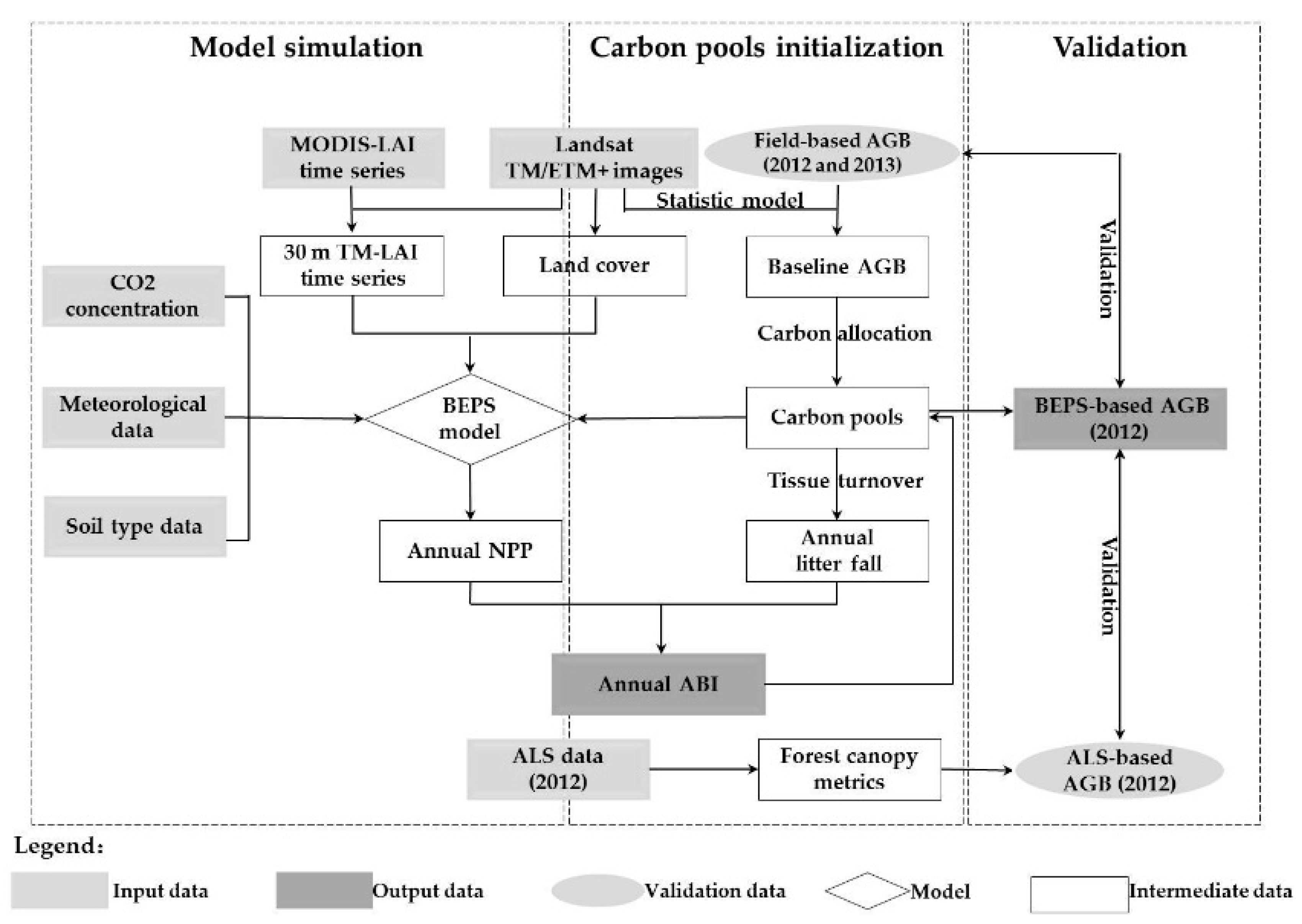
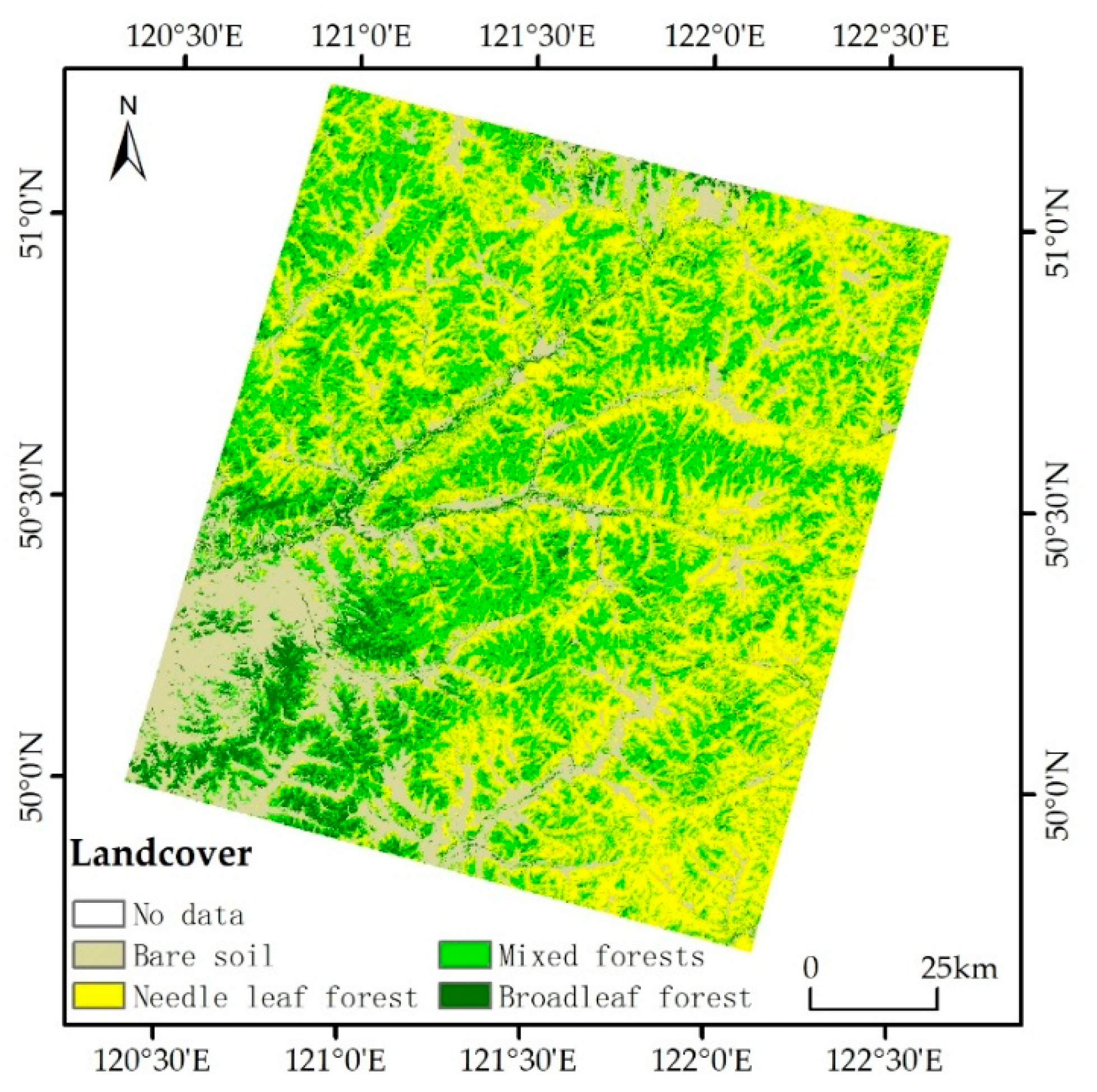
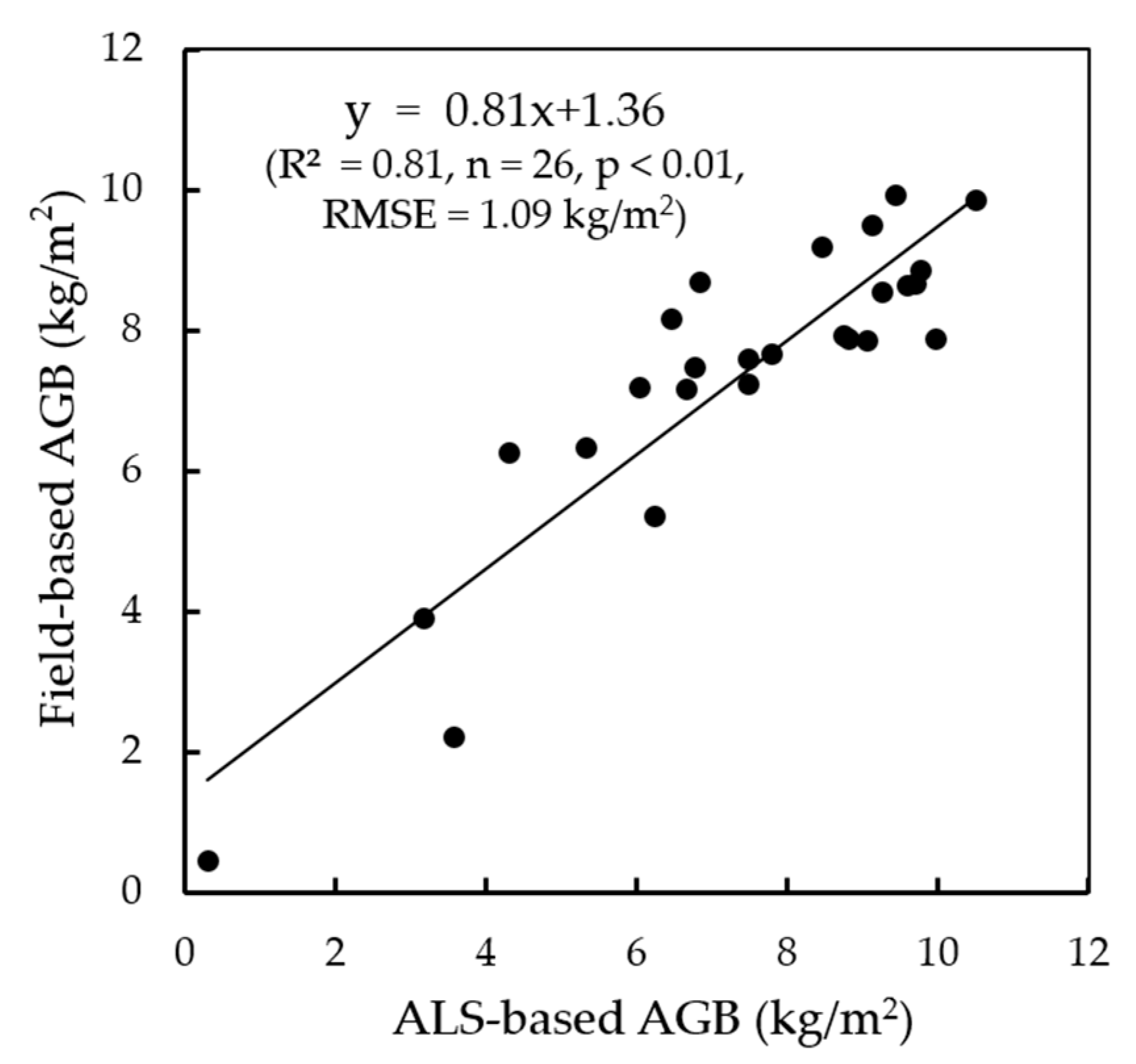

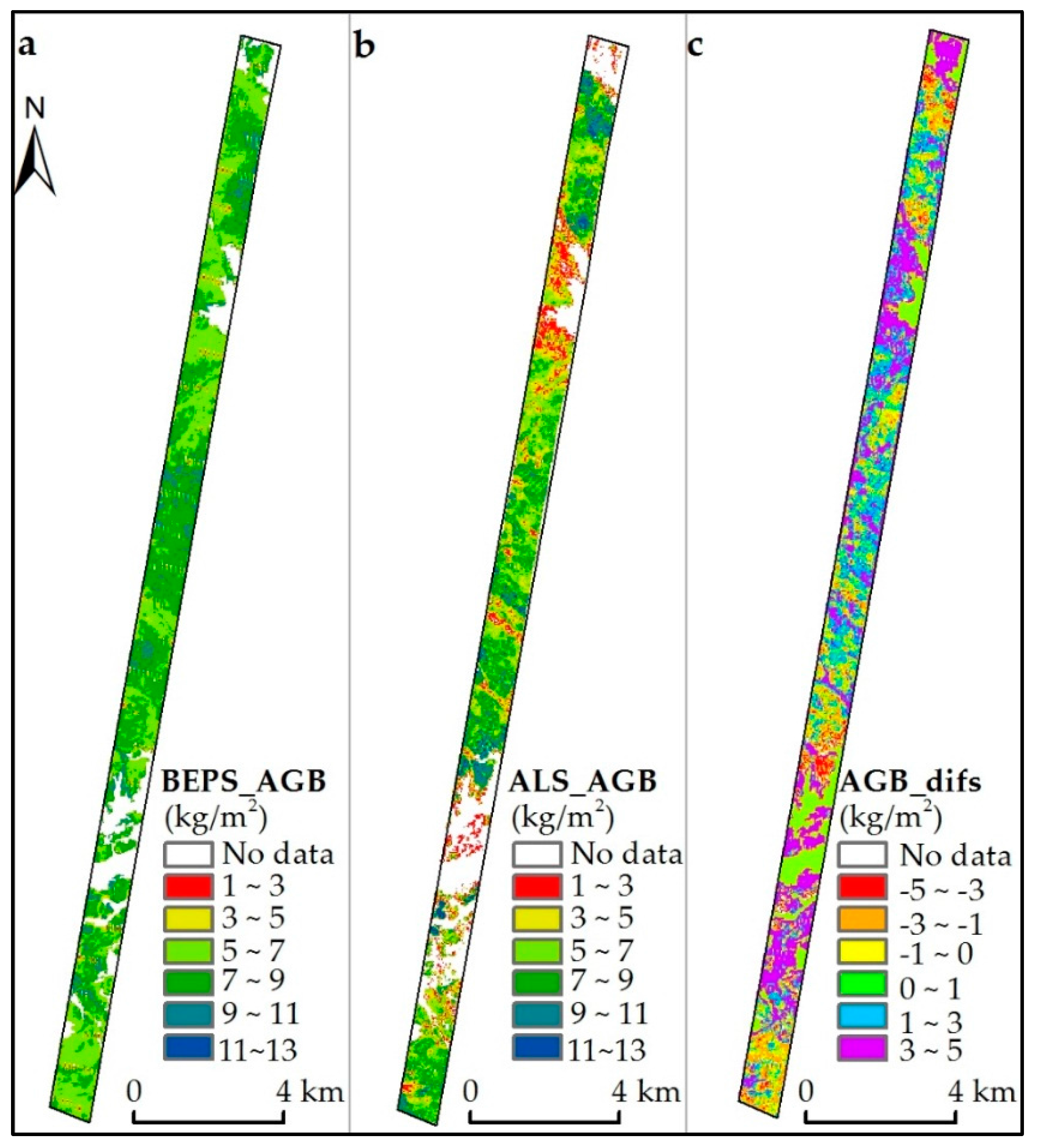
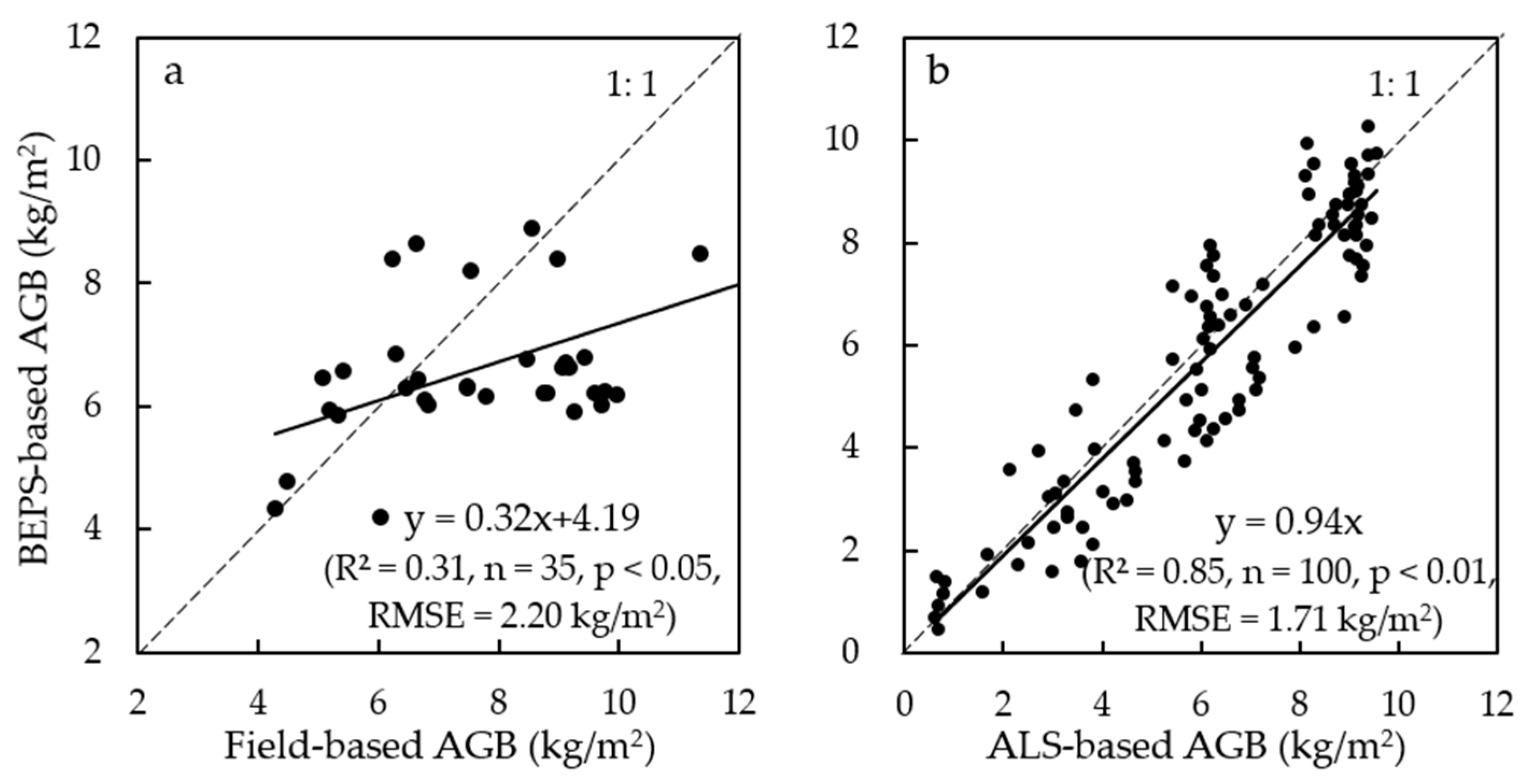
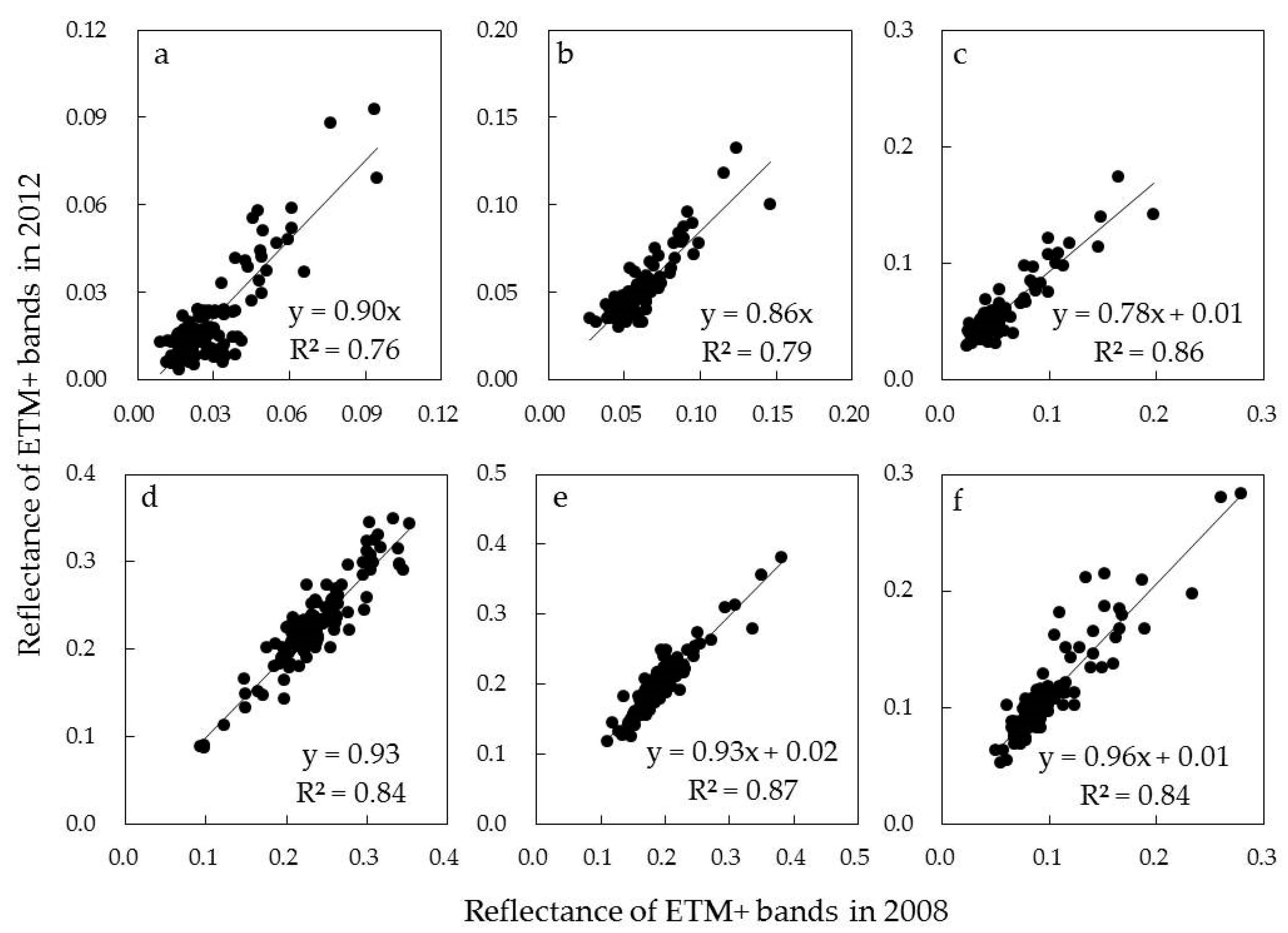

| Species | Stem Biomass | Branch Biomass | Leaf Biomass | Source |
|---|---|---|---|---|
| Larch | Ws = 0.0461 × (D2H)0.8722 | WB = 0.0356 × (D2H)0.5624 | WL = 0.0140 × (D2H)0.5628 | [41] |
| Pine | Ws = 0.3364 × D2.0067 | WB = 0.2983 × D1.144 | WL = 0.2931 × D0.8486 | [42] |
| Birch | Ws = 0.0494 × (D2H)0.9011 | WB = 0.0142 × (D2H)0.7686 | WL = 0.0110 × (D2H)0.6472 | [41] |
| Aspen | Ws = 0.2286 × (D2H)0.6933 | WB = 0.0247 × (D2H)0.7378 | WL = 0.0108 × (D2H)0.8181 | [41] |
| Parameters | Needle Leaf Forest | Broadleaf Forest | Mixed Forests |
|---|---|---|---|
| Wood CAC | 0.301 | 0.462 | 0.382 |
| Leaf CAC | 0.213 | 0.223 | 0.208 |
| Coarse root CAC | 0.148 | 0.119 | 0.154 |
| Fine root CAC | 0.348 | 0.196 | 0.257 |
| Wood TR | 0.028 | 0.029 | 0.028 |
| Leaf TR | 1.000 | 1.000 | 1.000 |
| Coarse root TR | 0.027 | 0.045 | 0.027 |
| Fine root TR | 0.595 | 0.595 | 0.595 |
| Forest Type | Sample No. | Statistical Models | R2 | p < |
|---|---|---|---|---|
| Needle leaf | 24 | 0.72 | 0.01 | |
| Broadleaf | 21 | 0.42 | 0.05 | |
| Mixed | 29 | 0.57 | 0.01 |
| ALS Metrics | hm | d | h10 | h20 | h30 | h40 | h50 | h60 | h70 | h80 | h90 |
|---|---|---|---|---|---|---|---|---|---|---|---|
| AGB | 0.91 | 0.56 | 0.78 | 0.85 | 0.87 | 0.88 | 0.89 | 0.89 | 0.88 | 0.88 | 0.87 |
| Forest Type | GPP (gC/m2) | NPP (gC/m2) | AGB (kg/m2) | Increment of GPP (gC/m2/yr) | Increment of NPP (gC/m2/yr) | Increment of AGB (ABI) (kg/m2/yr) |
|---|---|---|---|---|---|---|
| Needle leaf | 1322 | 672 | 6.29 | 42.39 | 13.82 | 0.16 |
| Broadleaf | 1319 | 863 | 8.01 | 37.87 | 14.81 | 0.14 |
| Mixed | 1613 | 679 | 7.88 | 40.47 | 14.97 | 0.20 |
© 2017 by the authors. Licensee MDPI, Basel, Switzerland. This article is an open access article distributed under the terms and conditions of the Creative Commons Attribution (CC BY) license (http://creativecommons.org/licenses/by/4.0/).
Share and Cite
Lu, X.; Zheng, G.; Miller, C.; Alvarado, E. Combining Multi-Source Remotely Sensed Data and a Process-Based Model for Forest Aboveground Biomass Updating. Sensors 2017, 17, 2062. https://doi.org/10.3390/s17092062
Lu X, Zheng G, Miller C, Alvarado E. Combining Multi-Source Remotely Sensed Data and a Process-Based Model for Forest Aboveground Biomass Updating. Sensors. 2017; 17(9):2062. https://doi.org/10.3390/s17092062
Chicago/Turabian StyleLu, Xiaoman, Guang Zheng, Colton Miller, and Ernesto Alvarado. 2017. "Combining Multi-Source Remotely Sensed Data and a Process-Based Model for Forest Aboveground Biomass Updating" Sensors 17, no. 9: 2062. https://doi.org/10.3390/s17092062
APA StyleLu, X., Zheng, G., Miller, C., & Alvarado, E. (2017). Combining Multi-Source Remotely Sensed Data and a Process-Based Model for Forest Aboveground Biomass Updating. Sensors, 17(9), 2062. https://doi.org/10.3390/s17092062





